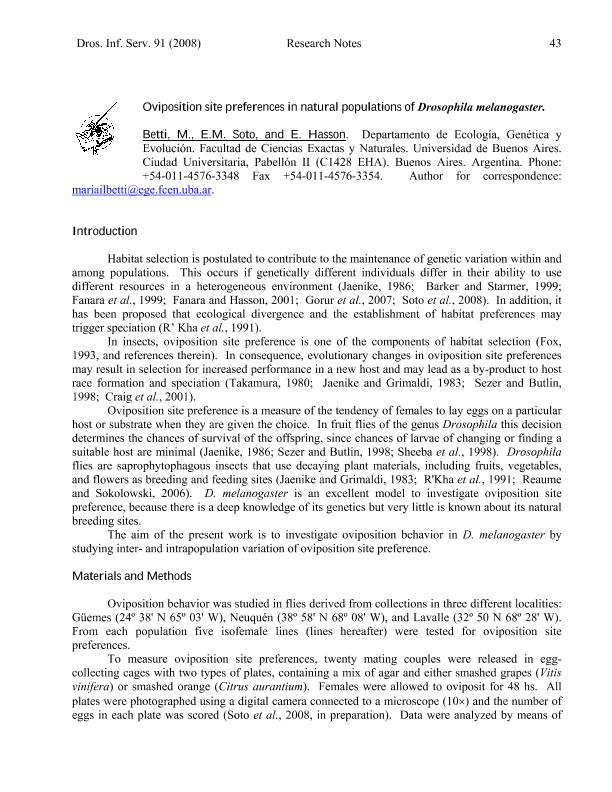Artículo
Oviposition site preferences in natural populations of Drosophila melanogaster
Fecha de publicación:
12/2008
Editorial:
University of Oklahoma
Revista:
Drosophila Information Service
ISSN:
0070-7333
Idioma:
Inglés
Tipo de recurso:
Artículo publicado
Clasificación temática:
Resumen
Habitat selection is postulated to contribute to the maintenance of genetic variation within and among populations. This occurs if genetically different individuals differ in their ability to use different resources in a heterogeneous environment (Jaenike, 1986; Barker and Starmer, 1999: Fanara et al., 1999, Fanara and Hasson, 2001; Gorur et al., 2007; Soto et al., 2008). In addition, it has been proposed that ecological divergence and the establishment of habitat preferences may trigger speciation (R? Kha et al., 1991) In insects, oviposition site preference is one of the components of habitat selection (Fox, 1993 and references therein). In consequence, evolutionary changes in oviposition site preferences may result in selection for increased performance in a new host and may lead, as a by-product to host race formation and speciation (Takamura, 1980; Jaenike and Grimaldi, 1983; Sezer and Butlin, 1998; Craig et al., 2001). Oviposition site preference is a measure of the tendency of females to lay eggs on a particular host or substrate when they are given the choice. In fruit flies of the genus Drosophila this decision determines the chances of survival of the offspring since chances of larvae of changing or finding a suitable host are minimal (Jaenike, 1986; Sezer and Butlin, 1998; Sheeba et al., 1998). Drosophila flies are saprophytophagous insects that use decaying plant materials, including fruits, vegetables and flowers as breeding and feeding sites (Jaenike and Grimaldi, 1983; R´Kha et al., 1991; Reaume and Sokolowski, 2006). D. melanogaster is an excellent model to investigate oviposition site preference, because there is a deep knowledge of its genetics but very little is known about its natural breeding sites. The aim of the present work is to investigate oviposition behaviour in D. melanogaster by studying inter and intrapopulation variation of oviposition site preference.
Palabras clave:
Oviposition preference
,
Drosophila melanogaster
,
NATURAL POPULATIONS
Archivos asociados
Licencia
Identificadores
Colecciones
Articulos(IEGEBA)
Articulos de INSTITUTO DE ECOLOGIA, GENETICA Y EVOLUCION DE BS. AS
Articulos de INSTITUTO DE ECOLOGIA, GENETICA Y EVOLUCION DE BS. AS
Articulos(MACNBR)
Articulos de MUSEO ARG.DE CS.NAT "BERNARDINO RIVADAVIA"
Articulos de MUSEO ARG.DE CS.NAT "BERNARDINO RIVADAVIA"
Citación
Betti, María Isabel Luján; Soto, Eduardo Maria; Hasson, Esteban Ruben; Oviposition site preferences in natural populations of Drosophila melanogaster; University of Oklahoma; Drosophila Information Service; 91; 12-2008; 43-47
Compartir




